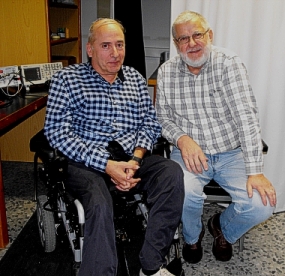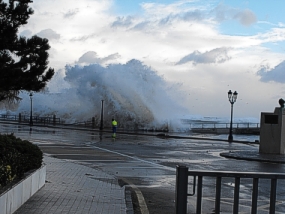|
Presentation Abstract
Since the 1944 discovery of electron paramagnetic resonance (EPR) in bulk matter and that of nuclear magnetic resonance (NMR) in 1945, magnetic resonance has never stopped evolving and sprouting new branches, some of them quite unexpected and fascinating. This explains the incredible intellectual attraction of MR techniques: it is true, in fact, that while most MR practitioners come from other fields, MR itself practically never looses an adept.
This talk attempts a broad review of MR phenomena and of their practical exploitation, following the manifold historic threads, then taking a snapshot of the current status, and finally attempting a guess at what might come up in the near future.
Author's comments

I was invited to University of Cantabria in Santander (Northern Spain) by Ramón Niembro Barcena (on the left in the photo with me), a theoretical nuclear physicist who equipped one of their student labs with a tiny CW-NMR instrument produced by Leybold Didactic (it happens to be the only NMR at the University). It was fun to explore what this MR kitty can do. We used glycerol, copper-doped water, and a soap, saw some differences but concluded that the best use for the instrument was just to convince students that NMR signals really exist. But still, the magnet with its approximately 2"x2" square poles delivers about 200 Hz homogeneity across 3 mm samples.
Ramón urged me to keep the talk very introductory, with a bit of history, a panorama of applications, and a few words about future developments. Such talks, of course, are the most difficult to deliver and I must confess that I was not really as well prepared as I should have been. Fortunately, the weather was really terrible (see the photo) so I had to stay in my hotel. Which was bad since Santander is a pretty town on a beautiful coast, but not that bad since I could at least dedicate a full day to the preparation of the talk.
Sources

Some of the sources I have used come from websites which I no longer remember and therefore can not link to (but I am more than ready to amend this page should anybody mail me a complaint).
The sources I can trace and am glad to acknowledge are:
For the historic part about electron and proton spin, I draw significantly on a 2000 presentation by Homer Neal, entitled The Spinning Proton from which I also "stole" the two group photos, one of which can be traced to the Emilio Segre Visual Archives.
The photographs of Otto Stern, Walter Gerlach, Isidor Rabi and Felix Bloch come from the physics Nobel Prizes website. I don't have any idea where do the photos of Edward Purcell and Evgenij Zavoijsky come from, except that they appear to be in the public domain on internet (advice welcome).
I draw extensively on the Nobel lectures of many Nobel Prize laureates as well as on Wikipedia for the human-side content of some of the slides. For the scientific side of the historic part of the talk I draw on the original articles as listed in my own collections
The origins of the NMR data are:
- The sunflower seed FID I have measured myself about 25 years ago on an early Stelar Spinmaster.
- The chloroform (CHCl3) spectrum comes from the installation test-data CD of a Bruker 600 MHz spectrometer.
- The strychnine 1H spectrum was acquired by an unknown operator on a Varian (now Agilent) Inova 400 MHz spectrometer. If people do not sign their data, there is no way I can give them credit.
- The brucine 13C spectrum was acquired on a Bruker 500 MHz spectrometer and so was the 2D COSY.
- The DOSY spectrum comes from a poster by Carlos Cobas and myself presented in 2008 at a SMASH Conference.
- The 1H-NMRD profile of solid BSA comes from a poster by myself, Mauro Cremonini, Luca Laghi, and Paola Fantazzini, presented at a 2004 GIDRM Meeting.
All spectroscopic data were re-evaluated from original acquisition files using the Mnova software of Mestrelab Research.
|